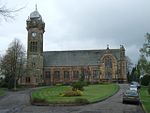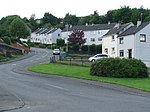Kilmacolm railway station
1869 establishments in ScotlandDisused railway stations in InverclydeFormer Glasgow and South Western Railway stationsPages with no open date in Infobox stationRailway stations in Great Britain closed in 1983 ... and 2 more
Railway stations in Great Britain opened in 1869Use British English from December 2017

Kilmacolm railway station was a railway station serving the village of Kilmacolm, in the current council area of Inverclyde and the historic county of Renfrewshire in the West-Central Lowlands of Scotland. It was originally part of the Greenock and Ayrshire Railway, later a line of the Glasgow and South Western Railway. The station was opened in 1869. Services west to Greenock were discontinued in 1959 and services to the east and into Glasgow ended in 1983 when the station was closed.
Excerpt from the Wikipedia article Kilmacolm railway station (License: CC BY-SA 3.0, Authors, Images).Kilmacolm railway station
Station Road,
Geographical coordinates (GPS) Address Nearby Places Show on map
Geographical coordinates (GPS)
| Latitude | Longitude |
|---|---|
| N 55.8931 ° | E -4.6295 ° |
Address
Pullman Tavern
Station Road
PA13 4DW
Scotland, United Kingdom
Open on Google Maps






